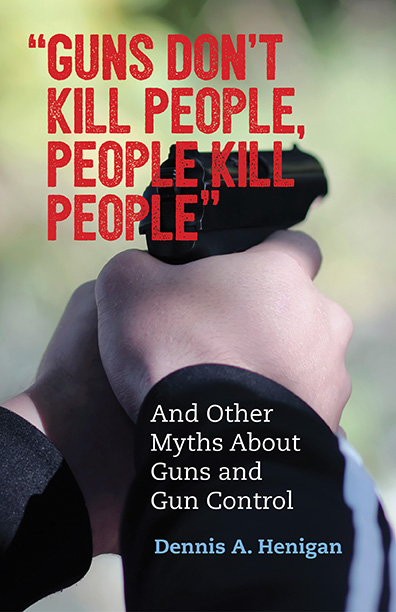Myth-busting Facts and Revelations from “Guns Don’t Kill People, People Kill People:” And Other Myths About Guns and Gun Control
The gun lobby says, “Guns don’t kill people. People kill people.” But assaults with guns are twenty-three times more deadly than assaults with other weapons. Guns enable people to kill people – more efficiently and effectively than other weapons.
The gun lobby dismisses the connection between gun availability and suicide, but 92% of attempted suicides with guns are completed, by far the most lethal suicide method. Since those who unsuccessfully attempt suicide with guns are actually less likely to try again than those who attempt suicide by other means, making guns less available to the suicidal will save lives.
Most people assume that gun violence is almost entirely an urban problem, while rural areas have little gun violence though they have lots of guns. But, in fact, rural, high-gun ownership states like Montana and Mississippi have firearm death rates three times higher than urbanized states like New Jersey and New York. Why? Because the gun suicide problem in rural areas is as significant as the gun homicide problem in major cities.
The gun lobby’s refrain is, “When guns are outlawed, only outlaws will have guns,” conveying the idea that gun control will never be effective in preventing criminal access to guns. Leaving aside the red herring of “outlawing guns,” the one category of guns that has long been subject to a strict federal licensing and registration system – machine guns – is an insignificant crime problem, even though machine guns have an obvious appeal to criminals. The National Rifle Association has admitted that, after over 50 years of strict federal regulation, possession of machine guns “has never been a crime problem.” According to federal data, machine guns account for around 0.1% of guns traced to crime.
The gun lobby insists that “An armed society is a polite society,” because in areas with more guns, criminals allegedly live in fear of law-abiding gun owners. But, in fact, residents of the states with the highest rates of gun ownership (like Louisiana and Alabama) are over twice as likely to become homicide victims as those in the states with the lowest rates of gun ownership (like Massachusetts and New Jersey).
The gun lobby claims that “an armed society is a polite society,” yet the United States has the highest rate of gun ownership in the industrialized world and a homicide rate that is over seven times the combined rate of twenty-two other high-income nations. Not very polite!
The gun lobby claims that ‘The only thing that stops a bad guy with a gun is a good guy with a gun,’ yet surveys show that guns are used in crime 4-6 times more frequently than they are used in self-defense.”
The gun lobby has relied largely on a study by economist John Lott in arguing for loosening restrictions on concealed weapons, yet Lott’s work has been ripped to shreds by more than a dozen independent scholars.
The gun industry claims licensed gun dealers have nothing to do with illegal guns, yet cannot explain why almost 60% of guns traced to crime originate with 1% of licensed gun dealers.
The gun industry claims gun manufacturers cannot know which of their dealers may be supplying the illegal market, but internal industry documents show that when federal authorities offered to provide gun makers with crime gun data that would have identified the dealers selling high numbers of guns traced to crime, manufacturers like Taurus and Sturm, Ruger declined the offer.
Gun manufacturers claim they know nothing about the role of their dealers in supplying the illegal market, yet documents uncovered during litigation show that manufacturers were constantly warned by legitimate dealers that there are “felons hidden among us.”
Gun manufacturers claim they could do nothing about the problem of corrupt dealers, yet industry whistleblower Robert Ricker stated, in sworn testimony, that the corrupt dealer issue was repeatedly discussed during meetings of industry lawyers, who eventually terminated the meetings because the discussions were too “dangerous.”
Gun manufacturers claim they were unaware of the problem of corrupt dealers, yet an internal 1993 industry trade association document uncovered in litigation suggested a “proactive industry strategy” to address the problem of “unscrupulous” dealers. The document was filed “for future reference” and no action was taken.

